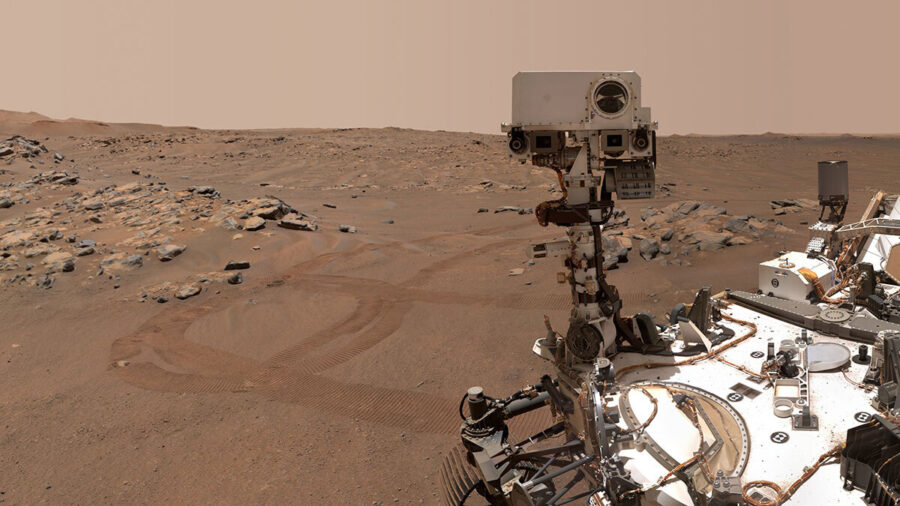The mission team has reported results from Perseverance’s study of the rocks deposited by the river that once flowed into Jezero Crater.

NASA / JPL-Caltech / ASU / MSSS
NASA has announced a status update on the Perseverance rover trundling through Jezero Crater on Mars, highlighting news from the mission's second science campaign.
Scientists already know that Jezero was filled with a lake some 3.5 billion years ago, fed in part by a river that broke through the walls of the crater rim. Now, scientists are revealing the first results from investigations of the delta deposits that river left behind.
Lava First, Water Second
In the first science campaign, during which Perseverance explored the crater floor, the rover found not squished sedimentary layers but igneous rocks, evidence that volcanic activity once deposited material inside Jezero.

NASA / JPL-Caltech / MSSS
“Our Planetary Instrument for X-ray Lithochemistry (PIXL) instrument got a good look at the abraded patch of a rock from the area nicknamed ‘South Séítah,’ and it all became clear: The crystals within the rock provided the smoking gun,” explains Perseverance project scientist Ken Farley (Caltech).
What PIXL saw were large olivine crystals encased in pyroxene crystals, formed long ago in slowly cooling magma. That magma may have flowed thick on the surface or lain underground in a chamber. In any case, after it crystallized, other chemical evidence shows these minerals later interacted with water not just once but multiple times.
Perseverance collected several samples of these igneous rocks. When a future mission returns these samples to Earth, scientists in Earth-based labs will be able to test them to determine when water filled Jezero Crater.
NASA / JPL-Caltech / ASU / MSSS
But all the while the rover drove on the crater floor, many scientists' eyes were on the delta in the distance. There, a river had once breached the crater rim and met the lake that filled Jezero, depositing sediments. There was scientists' best chance to detect signs of life, if they exist.
To drive to the ancient delta, Perseverance first had to dash around vast sand dunes, using autonomous navigation to help complete a drive of 5 kilometers (3 miles) in just over 31 days, a record for the rover.
After an April arrival, the team spent five months examining sedimentary rocks in what they call the Delta Front Region. The team took two samples each from two ridges, Skinner and Wildcat. The two ridges are very different, says David Shuster (University of California, Berkeley). Skinner Ridge has a mixture of sedimentary rocks that have traveled to the delta from a long ways away, while Wildcat Ridge hosts sulfate- and salt-bearing mudstone. These rocks would have formed in salty brines as the lake water evaporated.
While igneous rocks can't preserve organic matter, sedimentary rocks are different: They easily preserve biosignatures, so if biological activity were present when the sedimentary rocks formed, the rock core samples would likely reveal it, Shuster explains. "If these conditions existed on Earth over the last 3.5 billion years, it's safe to say biology would have left its mark in these rocks for us to observe."
(It's important to note, though, that the surface of Mars today is completely inhospitable to life — any signs of life found on the surface, if found at all, would be ancient, having lived billions of years ago. Fortunately for us, the Martian surface doesn't change much, and might preserve even such ancient signatures.)
Although the search for definitive signs of life will have to wait for the sample return, Perseverance can look for some non-definitive signs of life now, using its SHERLOC instrument. SHERLOC's Raman spectrometer has revealed the presence of organic matter, likely aromatic compounds, tied to sulfate minerals in the rocks, says SHERLOC scientist Sunanda Sharma (JPL).
Organic molecules contain carbon and typically hydrogen and oxygen, too, and are commonly produced by life processes. But such so-called "organic" molecules are also produced via purely chemical processes that have nothing to do with life, cautions Sharma. Mapping out the distribution of organic material is key to determining how it was produced — and that's something we don't know just yet.
The new readings from Perseverance are also helping scientists sort out the geologic history in the crater, which is key to putting any potential biosignatures in context. While they're still sorting out an exact timeline, it seems clear that the magmatic activity came first: The igneous rocks on the crater floor "are clearly beneath the delta, emplaced before delta was emplaced, before the lake was present," says Farley.
But exactly when each of those things happened, and how many millions of years elapsed in between, and how many times the crater filled with water, and when the river dumped the delta deposits — all that is up in the air until scientists can run tests on samples in earthbound labs.
Samples and Sample Return

ESA
Perseverance has now collected 13 samples to date. You can view the Mars rock sample data on NASA's website. For 12 of the samples, the rover drilled into a rock to remove a core; in one additional case, the rock core crumbled and fell out of the collection tube, but the tube still contains Martian atmosphere.
That's impressive progress over the 1½ years since Perseverance landed on Mars, considering the rover carries 38 tubes available for samples. (Another five tubes are reserved as "witness" tubes. They carry materials that, when exposed to Martian air, may react in different ways.)
With about one-third of their samples collected, mission scientists are now preparing to execute Perseverance's first cache drop, leaving themselves a package to pick up later. In this plan, Perseverance would bundle and drop 10 or 11 tubes near the delta front. Then, when a Mars Sample Return suite of spacecraft launches, Perseverance could retrieve and deliver the samples.
Alternatively, if Persie isn't doing well or is too far away, the sample-return mission might deploy two helicopters to aid in sample collection. Designers will base the retrieval copters on Ingenuity, the helicopter that's still going strong after 18 months on the Red Planet. However, Rick Welch, Perseverance's deputy project manager, adds that the new helicopters will also need to be equipped with wheels for scooting around on the surface.
NASA and ESA are planning the Earth Return Orbiter and Sample Retrieval Lander for fall 2027 and summer 2028, respectively. Samples would then come to Earth by 2033. And then the fun will really begin!
 0
0









Comments
You must be logged in to post a comment.